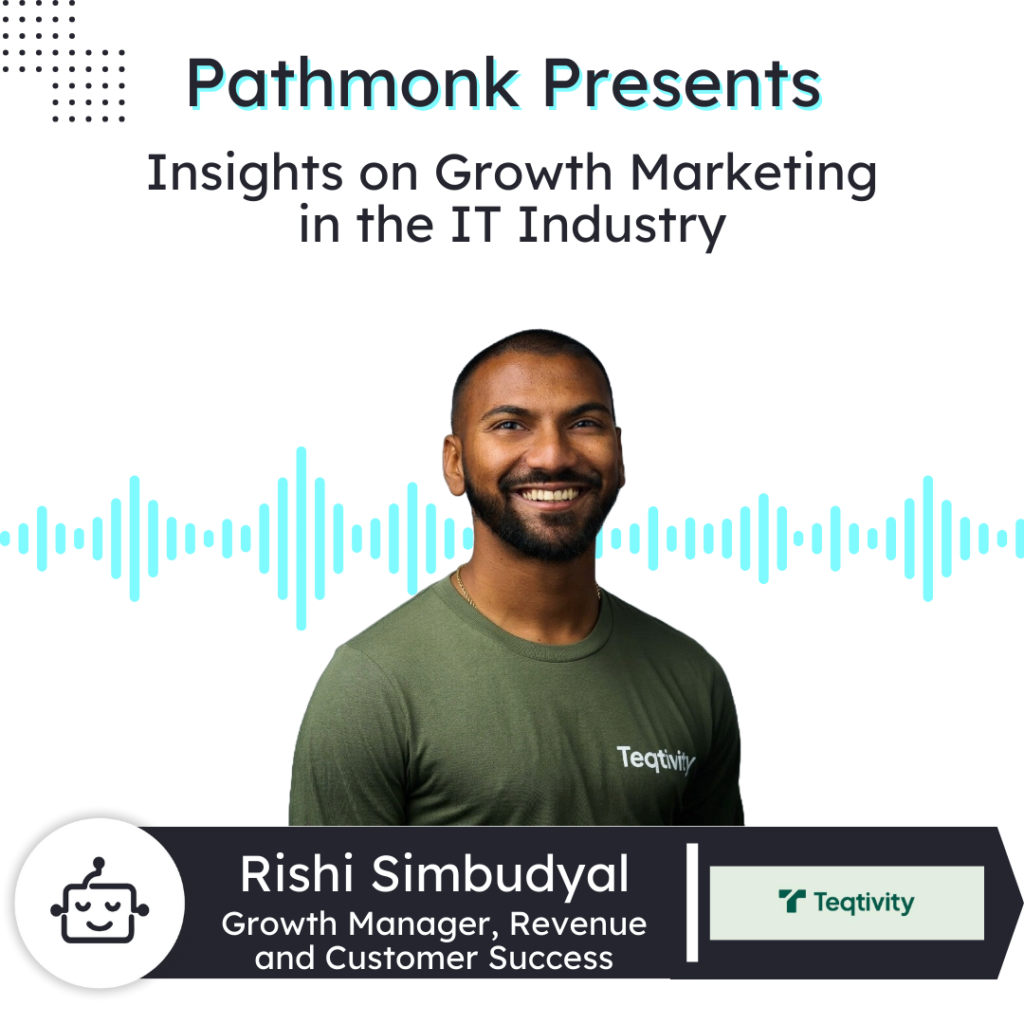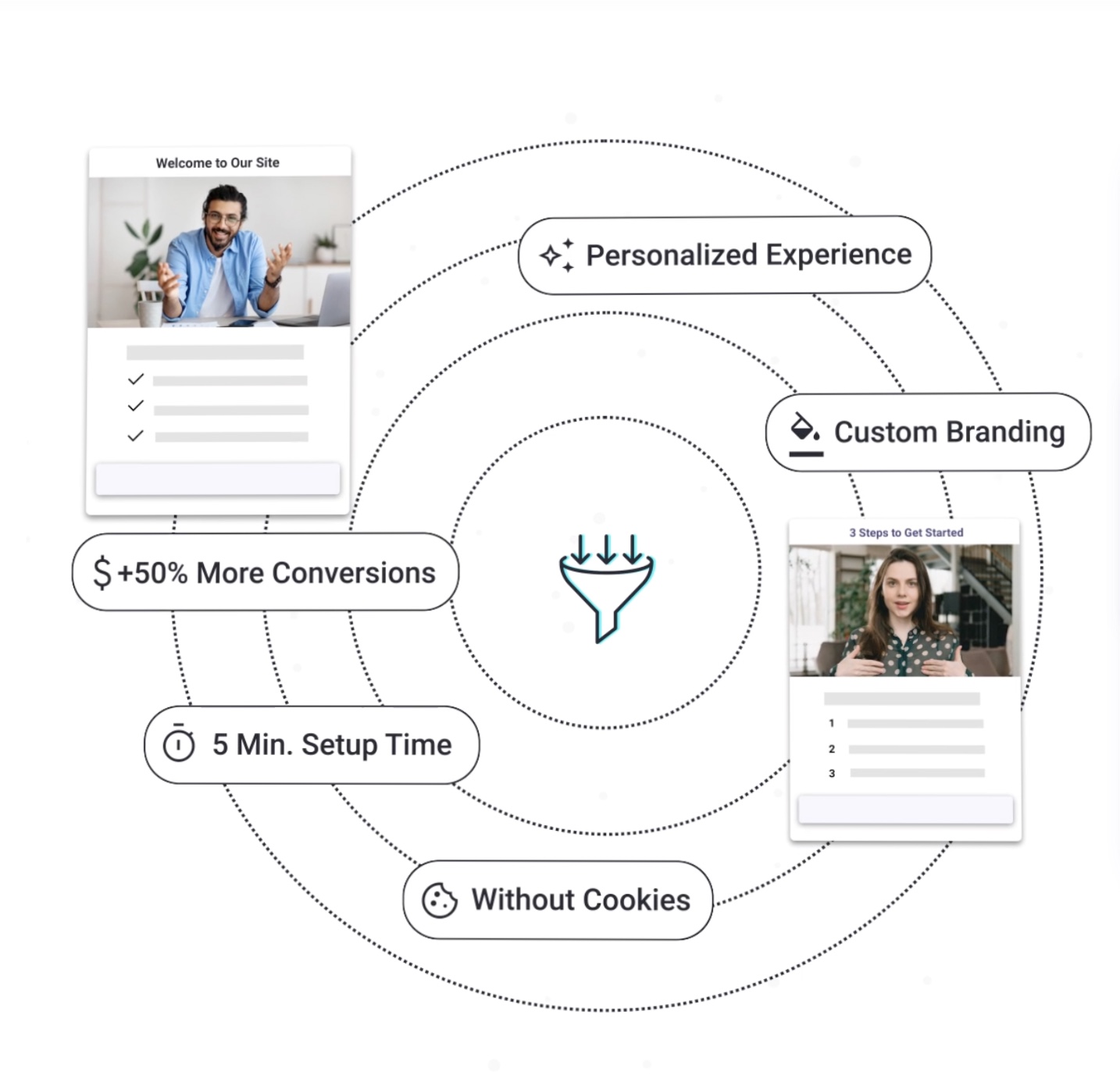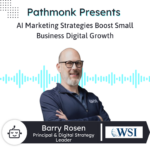
Introduction
In this enlightening episode, we welcome Rishi Simbudyal, the Growth Manager at Teqtivity, an innovative IT asset management startup.
Rishi discusses Teqtivity unique approach to pricing, integration capabilities, and commitment to customer education. Rishi also shares valuable insights on lead generation strategies, the importance of website optimization, and how Teqtivity is addressing common pain points in the industry.
This episode is a must-listen for IT marketing professionals and business leaders looking to streamline their marketing strategy and drive growth.
More Sales From Your Website With AI
Personalized interactions based on your users' behaviour to get +50% more conversions.

Ernesto Quezada: Pathmonk is the intelligent tool for website lead generation. With increasing online competition, over 98% of website visitors don’t convert. The ability to successfully show your value proposition and support visitors in their buying journey separates you from the competition online. Pathmonk qualifies and converts leads on your website by figuring out where they are in the buying journey and influencing them in key decision moments with relevant micro-experiences like case studies, intro videos, and much more. Stay relevant to your visitors and increase conversions by 50%. Add Pathmonk to your website in seconds. Let the AI do all the work and get access to 50% more qualified leads while you keep doing marketing and sales as usual. Check us on pathmonk.com. Welcome to today’s episode. Let’s talk about today’s guest. We have Rishi, growth manager with Teqtivity. How are you doing today, Rishi?
Rishi Simbudyal: I’m doing good. I’m doing good. Thanks for having me.
Ernesto: It’s great to have you on today’s show. Really curious and, you know, what is Teqtivity all about? Let’s start off with that. In your own words, Rishi, what is Teqtivity?
Rishi: Yeah, absolutely. Great question, by the way. Teqtivity is an ITAM startup. We provide tools for organizations to become and remain compliant, as well as we offer smart vending solutions. We are based in LA, but we maintain a global presence with our operations. IT asset management, or ITAM, as you would hear me refer to it throughout this, is a core function of every IT organization. Its main goals are to manage assets like laptops, peripherals, and software licenses, whether they’re tangible or intangible. These items need to be accounted for, deployed, maintained, and disposed of correctly and in compliance with ISO and other industry standards. That’s where Teqtivity comes in. We bring a new age of thinking to ITAM and the implementation of an ITAM tool in order to equip organizations with better, cleaner, more scalable data that they can use for actionable insights throughout the organization. Our solutions have capabilities to integrate with your full tech stack, like your service management tools, procurement tools, and security platforms. All of this we do to create a single source of truth. What we want, our goal with Teqtivity, is to make sure that it’s a single source of truth for every IT organization. Now, at its core, that is how all ITAM tools should work, but it’s quite a logistical nightmare, and it’s costly, too, with development to get to that level of a single source of truth. So, with Teqtivity, this is how we’re breaking the mold. We aim to provide as many of these tools, integrations, and workflows as out-of-box functionality in order to decrease the ongoing headaches and costly friction that occurs within the industry to create a single source of truth. Because of this, Teqtivity carries a heavy focus on our customers and our products. So we’re constantly building and innovating to be better for our current and future customers. That’s a little bit about us, right?
Ernesto: Awesome. That’s great to hear. And so maybe our audience, our listeners, can get a better understanding. Is it fair to say you say goodbye to spreadsheet chaos and help with cost savings, real-time control, and automation? What would you say is a key problem that you guys solve?
Rishi: Yeah, absolutely. Given the necessity of ITAM in every organization, yes. The main thing, the most common one we see is that people are using spreadsheets. But the problem that we really solve for is twofold. Teqtivity as an organization and our products, we have a unique solution, and the solution itself solves industry and organizational problems. Industry-wise, there are a lot of nuisances and barriers of entry that make it really difficult for someone to implement an ITAM tool, especially if they’re a smaller media business. This is where you see those spreadsheets come into play. As that company grows with spreadsheets, it gets really complicated. A lot of ITAM failures happen. These problems are the cost of ongoing maintenance, paywalling for new features, and, of course, pricing. These barriers of entry make it really difficult for small to medium organizations to implement a tool that they, quite frankly, need but can’t access due to cost. They end up saying, “Hey, it’s just easier to operate without it,” and that’s when they run into a lot of problems. But for us, we know that ITAM is such a vital part of scaling, so we completely get rid of those barriers. We make it easy for everyone. We make it accessible regardless of your size. One example of how we do that is we flipped it on its head. We don’t do asset volume pricing; we focus more on user-based pricing. Regardless of the number of assets you have within your organization, we actually care about the people getting value out of it, the people getting value out of Teqtivity. Organizationally, yes, like you were saying, the lack of visibility is a big thing, overspending is a big thing, and lack of automation is a big thing in these places, which are issues you see when using manual tools like spreadsheets. The platform itself is very smart in handling those tasks. It takes your spreadsheets, converts them into actionable insights at a glance, and combines them with your other tools, like your HR tools, your Hibob, your BambooHR, or endpoint MDM solutions like Jamf and Kanji, or even service desk tools like ServiceNow and Zendesk. By combining all of those, you create that single source of truth. That’s really the big problem that we solve. That problem exists because all of these things operate independently within one IT department. The lack of visibility means they don’t have enough information to make actionable decisions. So that’s what Teqtivity does. It brings all of those into one place. And just the robust reporting that we have automatically provides better visibility on how you’re spending, where you’re spending, and how to budget better.
Ernesto: Definitely. That’s great to see. Now, I am checking your website to get a better understanding of your segment vertical. I see here Uber, Turo, Model Eagle, Carless, Fintech. What vertical would you say you guys like to go after?
Rishi: Yeah, because of the nature of where ITAM is, we are industry-agnostic. But we see that our tool is most utilized in fintech, like you mentioned, healthcare, e-commerce, transportation, and software development. A lot of times we see those areas that have heavy regulation, a heavy necessity on privacy and data, and things like that. Those are where ITAM tools are usually more beneficial. But we are industry-agnostic. We don’t have a specific vertical. We want to help everyone, as many people as we can, definitely.
Ernesto: All right, awesome. Great to hear. And you being the growth manager there, Rishi, what does the top client acquisition channel look like for you guys?
Rishi: Actually, this might be quite surprising, but our audience typically finds us through our integration channels. We have about 45 integrations currently, like Zendesk and Jamf. We’re listed on their marketplaces as plugins. People who are customers of those services already tend to find us through there. Historically, that has been our top acquisition channel. Our website also does really well, and our sales and marketing team does a lot of heavy lifting. But historically, our website and our integration channels have proven to be very effective. However, this is changing. We’re putting a lot more resources into our sales, partnership, and expansion functions. But historically, yes, channels have been good for us.
Ernesto: That’s great to hear. And talking about your website, you guys can visit them at teqtivity.com. What role does the website play for your client acquisition?
Rishi: This is a great question. Our website definitely plays an integral role in our customer acquisition strategy. It’s probably one of the lowest numbers in our customer acquisition cost portfolio, given the returns we’ve seen from it. This is mainly because of what we focus on. We want to educate our customers or future customers to make the best decision possible without coercion. Coercion is so common in our industry, and we’ve seen many organizations unable to maintain the systems they’ve been baited into choosing, which down the line leads to ITAM failures. That’s very painful. Every time we see a customer come by and say, “Hey, we had this system, and this is what happened,” it sucks. We don’t wish that on anyone. Every ITAM solution out there sells the same core products, but on our website, we focus on educating the customer about not only how we can solve their ITAM issues but also how we can support their organization after they’ve implemented a tool like ours. We’ve seen a great conversion rate on that. We’re very transparent about what we offer and how we offer it through things like blogs and infographics. We want our customers to have all the tools to make the best decision possible, even if that’s not us. We would like them to make the best decision possible. The second thing is probably the ease of access. We pride ourselves on being accessible to our clientele, making it easy for them to access those materials and not overcomplicating it. Giving them the tools and the options to contact us, simple things like that, is what converts our website into such a good source for our lead generation.
Ernesto: All right, awesome to hear that. Now, as far as 2023, with all the talk about AI and trends, was there any tool or method that you guys started using this year after this huge AI boom?
Rishi: Yes, I wouldn’t say specifically any AI tools. There are some items within the existing software that we have that have AI components now, which we’re slowly getting into. Are you mentioning in terms of the website or in general at Teqtivity?
Ernesto: It could be in general with Teqtivity or in terms of website lead generation. It was a huge year for AI, so people started using it in different ways. I’m just curious if at Teqtivity you guys used it in any way?
Rishi: Not AI specifically, but you touched on something that’s a trend happening. We’re moving away from personal connections, especially through websites. It tends to be really cold. When I joined Teqtivity, our lead capture was very SaaS-typical. A big problem in the sales organization at Teqtivity at the time was no-shows. My biggest challenge was how to address this. I’m not a fan of no-shows, definitely. I see this mistake all the time where websites focus heavily on lead capture, but then they put them through submitting a form and waiting a few hours or even days. I could never understand that. That’s the trend I see with AI right now. Yes, it makes it easier, but it takes away that personal connection that people need. Sales psychology teaches us that buyers want to buy when they’re interested, right? Someone browsing your website has some kind of interest. So why put them through something like that? That’s what I call dead time, the time between when someone submits a form and when you get back to them. It’s the difference between the interest they had for your organization and your competitor. How do you bridge that gap? Organizations, especially SaaS, need to make it easier for prospects to get access to you, whether that’s integrating some kind of AI chatbot tool or just making a way for them to ask their questions on their terms. Give them options. Keep the SaaS-typical lead gen form, but also give them an opportunity to book a call or speak to someone live. A good combination is healthy, not just moving away from one to the other. Trust me, this will save your sales team a lot of time weeding out uninterested MQLs. In a world of disconnect, a conversation can change everything in a deal. The tip here is twofold. Invest in that interaction, whether it’s an AI chatbot or letting prospects ask questions in real time. Give them the answers they want without making them wait. The second thing is adding a calendar to your website. If someone is looking for something and they’re really interested, give them the option to book a demo right away. This decreased our no-shows. You save yourself five touches with that prospect, and you have a higher chance of closing that deal because they’re interested in booking a time to speak.
Ernesto: Definitely. Awesome to hear that from you, Rishi. Let’s switch gears a little bit for our listeners and talk about you as the growth manager at Teqtivity. What are some key tasks you focus on in your day-to-day work?
Rishi: As a growth manager, my role extends over growth, revenue, and customer success. Naturally, my day tends to be a mix of those. I’m focused on building new strategies for growth and how we can optimize our existing strategies, tools, and processes to increase our outputs against our metrics. These functions are all fairly new to Teqtivity, so we’re very much in build and test mode. For example, with our revenue team, I’m focused on making sure we’re aiming in the right direction with validating our value propositions, establishing the proper ICPs, and making sure they’re enabled. We’re building the systems for scale. Those are some key tasks within revenue. In customer success, our newest function that I’m building out, the goal is to make our customers’ lives easier, increase interaction, and reduce retention. Key tasks there include QBRs, customer meetings, understanding what they want, and how we can support their goals as an organization. Overall, this quarter I’ve been focused on pipeline optimization, launching a new product, and figuring out how to do more with less. Where can we reduce? Where can we automate? A lot of out-of-the-box thinking like that.
Ernesto: It sounds like every day can be something different. So every quarter there’s a new challenge.
Rishi: No two days are the same, I’ll tell you that.
Ernesto: Let’s jump into the rapid-fire question round. Are you ready, Rishi?
Rishi: Yeah, let’s go.
Ernesto: First off, what is the last book that you read?
Rishi: The last book I read is “It’s Your Ship” by Captain Michael Abrashoff.
Ernesto: What is one single thing that your company is focused on the most at the moment?
Rishi: Right now, we’re focused on our go-to-market. Our product was introduced in early stages. We’re reinventing the wheel on it to ensure it’s going to market right in preparation for a new product launch. So getting everything in place for that launch is a big focus.
Ernesto: If there were no boundaries in technology, what is one thing you would want to have fixed for your role as a marketer today?
Rishi: Real-time analytics or the ability to pivot quickly. The biggest challenge in growth is always playing catch-up with the market and trends. We spend so much time on research, testing, and validation for trends that don’t even last long. I wish we had real-time analytics on market trends, user behavior, and sales opportunities to pivot faster and recuperate quicker. It’s a very dynamic market.
Ernesto: Is there a repetitive task that you still have to do that you could automate? What would that be?
Rishi: Yes, updating assets and collateral. We have many moving parts, new content every quarter, every week. Updating our assets and collateral is something I wish I could just click a button and get done.
Ernesto: What is one piece of advice you would give yourself if you were to restart your journey as a marketer today?
Rishi: Become customer-centric earlier in my career. Continue to be as customer-centric as possible. Listening to your customers will guide your marketing strategies and contribute to long-term success. Invest in customer research, feedback loops, and building customer success functions earlier. Customers should be your primary source for market validation.
Ernesto: Great advice. Rishi, thanks a lot for being on the show with us today. I want to give you the last word. If everyone forgets everything about the interview today, what is the one thing they should remember about Teqtivity?
Rishi: The one thing they should remember about Teqtivity is that we’re here to provide a solution to people and organizations that otherwise wouldn’t have access to it. We’re here to make it easy, not the typical ITAM solution. Our goal is to make it as easy as possible for everyone to manage their assets better.
Ernesto: Awesome. For our listeners, if you want to check them out, go to teqtivity.com. IT asset management made easy. Rishi, thank you so much for being with us today. To our listeners, thank you for tuning in, and we’re looking forward to our next episode at Pathmonk Presents. Thanks, Rishi.
Rishi: Love it. Thanks, Ernesto.










